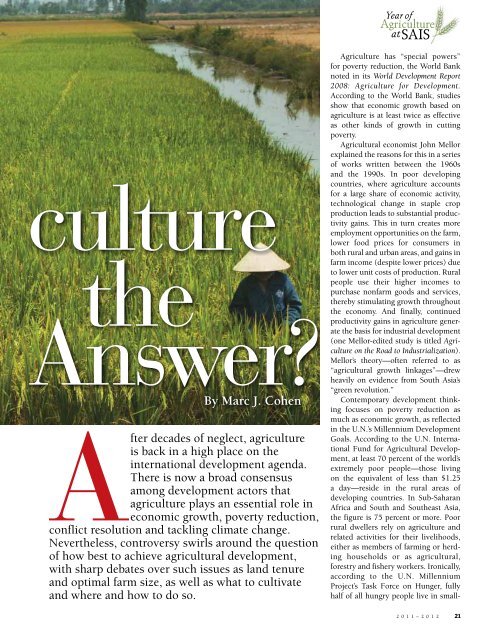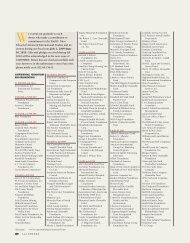Download Current Issue - SAIS
Download Current Issue - SAIS
Download Current Issue - SAIS
You also want an ePaper? Increase the reach of your titles
YUMPU automatically turns print PDFs into web optimized ePapers that Google loves.
culture<br />
the<br />
Answer?<br />
By Marc J. Cohen<br />
After decades of neglect, agriculture<br />
is back in a high place on the<br />
international development agenda.<br />
There is now a broad consensus<br />
among development actors that<br />
agriculture plays an essential role in<br />
economic growth, poverty reduction,<br />
conflict resolution and tackling climate change.<br />
Nevertheless, controversy swirls around the question<br />
of how best to achieve agricultural development,<br />
with sharp debates over such issues as land tenure<br />
and optimal farm size, as well as what to cultivate<br />
and where and how to do so.<br />
Year of<br />
Agriculture<br />
at<strong>SAIS</strong><br />
Agriculture has “special powers”<br />
for poverty reduction, the World Bank<br />
noted in its World Development Report<br />
2008: Agriculture for Development.<br />
According to the World Bank, studies<br />
show that economic growth based on<br />
agriculture is at least twice as effective<br />
as other kinds of growth in cutting<br />
poverty.<br />
Agricultural economist John Mellor<br />
explained the reasons for this in a series<br />
of works written between the 1960s<br />
and the 1990s. In poor developing<br />
countries, where agriculture accounts<br />
for a large share of economic activity,<br />
technological change in staple crop<br />
production leads to substantial productivity<br />
gains. This in turn creates more<br />
employment opportunities on the farm,<br />
lower food prices for consumers in<br />
both rural and urban areas, and gains in<br />
farm income (despite lower prices) due<br />
to lower unit costs of production. Rural<br />
people use their higher incomes to<br />
purchase nonfarm goods and services,<br />
thereby stimulating growth throughout<br />
the economy. And finally, continued<br />
productivity gains in agriculture generate<br />
the basis for industrial development<br />
(one Mellor-edited study is titled Agriculture<br />
on the Road to Industrialization).<br />
Mellor’s theory—often referred to as<br />
“agricultural growth linkages”—drew<br />
heavily on evidence from South Asia’s<br />
“green revolution.”<br />
Contemporary development thinking<br />
focuses on poverty reduction as<br />
much as economic growth, as reflected<br />
in the U.N.’s Millennium Development<br />
Goals. According to the U.N. International<br />
Fund for Agricultural Development,<br />
at least 70 percent of the world’s<br />
extremely poor people—those living<br />
on the equivalent of less than $1.25<br />
a day—reside in the rural areas of<br />
developing countries. In Sub-Saharan<br />
Africa and South and Southeast Asia,<br />
the figure is 75 percent or more. Poor<br />
rural dwellers rely on agriculture and<br />
related activities for their livelihoods,<br />
either as members of farming or herding<br />
households or as agricultural,<br />
forestry and fishery workers. Ironically,<br />
according to the U.N. Millennium<br />
Project’s Task Force on Hunger, fully<br />
half of all hungry people live in small-<br />
2011–2012 21



